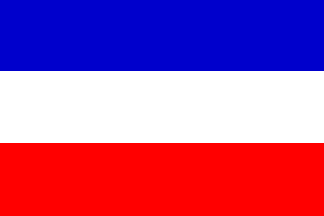
Last modified: 2017-11-11 by randy young
Keywords: independence | stars and stripes | patria vieja | reconquista | transition | transición | patria nueva |
Links: FOTW homepage |
search |
disclaimer and copyright |
write us |
mirrors

From the Cabildo Abierto of September 1810 until the defeat of patriotic forces at Rancagua in September 1814, the Chilean colony enjoyed a period of home rule that Chilean historiography calls La Patria Vieja (The Old Fatherland).
The government of José Miguel Carrera created «decreed the creation of a new cockade and flag to distinguish the patriots». On 30 September 1812, a horizontal tricolour was hoisted with blue over white over yellow, but it was never made an official symbol. According to Camilo Henríquez, «the flag represented the three values of the State: majesty, law and force».
After the signing of the Treaty of Lircay, Supreme Director Coronel Francisco de la Lastra ordered that the tricolour be replaced by the Spanish flag. The Patria Nueva was last used on 1,2 October at the Battle of Rancagua, which was the beginning of the Spanish reconquest.
Ned Smith, Jaume Ollé, Dov Gutterman, Sep 1999, & Alex Garofolo, 19 Jan 2015.
Quotations from: Emblemas Patrios - Gobierno de Chile (español)
The design of the Mapuche-Tehelche flag is certainly the same design of the first Chilean flag. The reason why it is used by native American groups is that apparently the design would have been used by some native American tribes in late 19 Century. In those times the tribes used to move freely from one side of the Andes to theother. It is possible that in that moment, someone from Chile gave them the idea to use that historical Chilean flag.
Francisco Gregoric, 16 Jul 2004
The 1812 Coat of Arms were also commissioned by José Miguel Carrera.
Jaume Ollé, 12 Sep 1999
The Obverse (front) |
The Reverse (back) |
||
|
|
|
Spain reconquered the jurisdiction in 1814 and held it until 1816. During this period the relevant Spanish flags were used.
António Martins, 29 Sep 2006

In February 1817, Chilean forces marched into the Battla of Chacabuco under the Argentine triband.
After the victory at Chacabuco, Juan Gregorio Las Heras created La Bandera de la Transición (The Flag of the Transition). The three stripes were attributed to Alonso de Ercilla, who's verses recalled a motto used by the Mapuches during the Reconquest:
«Por los pechos, al sesgo, atravesadas, bandas azules, blancas y encargadas»
TRANSLATION: On the chests, diagonally, blocking, sashes of blue, white and in-charge.
Red represented «the blood spilled on the battlefield», white was the snow on the Andes and blue, the sky over Chile. Like the Patria Nueva, this flag was never proumulgated as an official symbol. It was easily confused with the Netherlands' flag, which was part of the reason it fell out of use.
Jaume Ollé 12 Jun 1996, Dov Gutterman, 05 Sep 1999, & Alex Garofolo, 19 Jan 2015.
Quotations from: Emblemas Patrios - Gobierno de Chile (español)

There is some discrepancy as to who designed this flag, which is the prototype of the current flag. Officially, it was Minister of War José Ignacio Zenteno. Another source credits the Spanish soldier Antonio Arcos, as having designed it in collaboration with Zenteno. Yet another source credits the American Charles Wood.
It was adopted as the flag of the rebel army on 18 October 1817 under the Government of the Supreme Director, Captain General Bernardo O’Higgins through a decree of the Ministry of War headed by Secretary of State, Colonel José Ignacio Zenteno. The decree is known by only indirect reference as the original copy was never found. The national flag was used publicly for the first time on 12 February 1818, during the official proclamation of independence and the swearing ceremony of the flag, and it was carried by Colonel Tomas Guido.
The emblem that is charged overall has some elements in common with the arms of 1812 and 1819, particularly the oval shape, the column, globe and star. The book [c9L97] depicts an excellent image of the less know national arms of 1819-1834.
Dov Gutterman, 05 Sep 1999, Jaume Ollé 12 Jun 1996 & 2002, and Alex Garofolo, 19 Jan 2015.